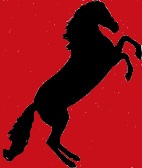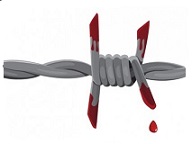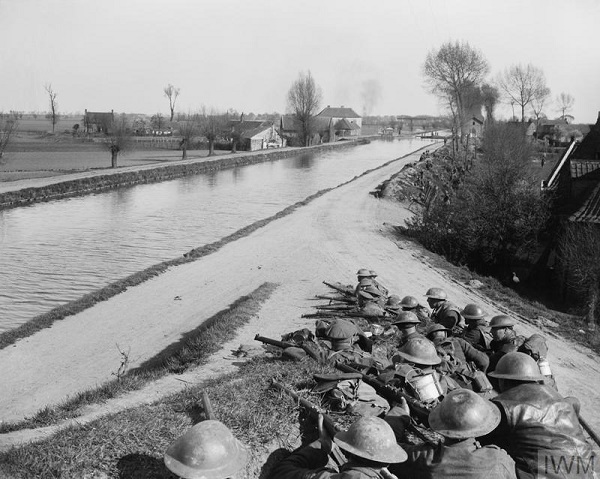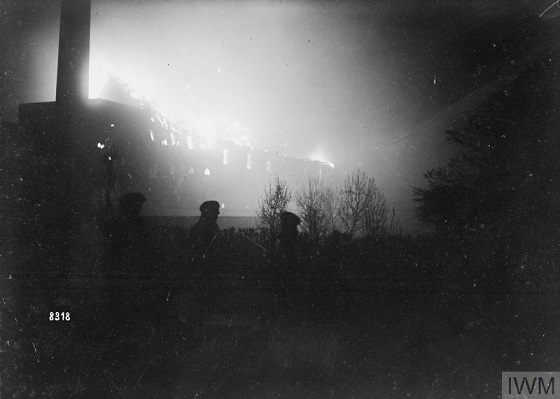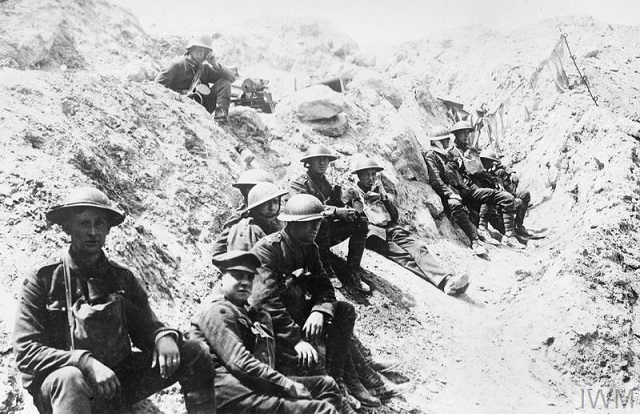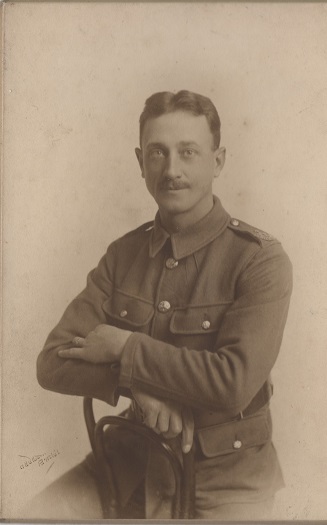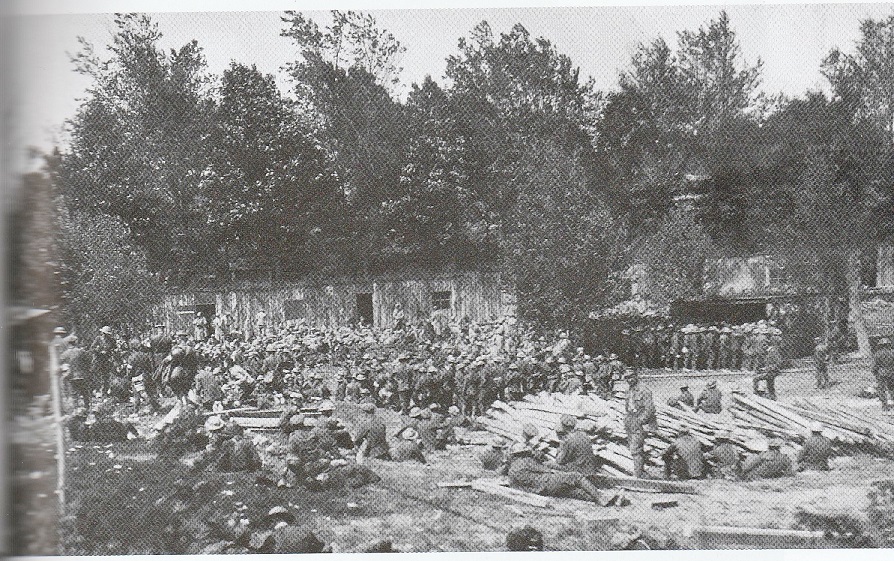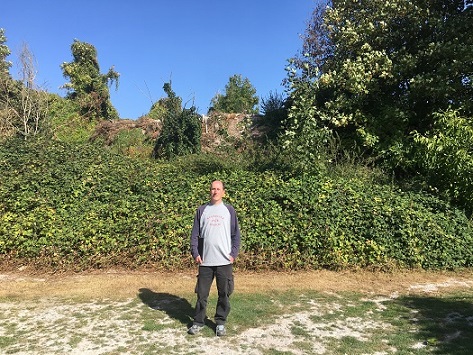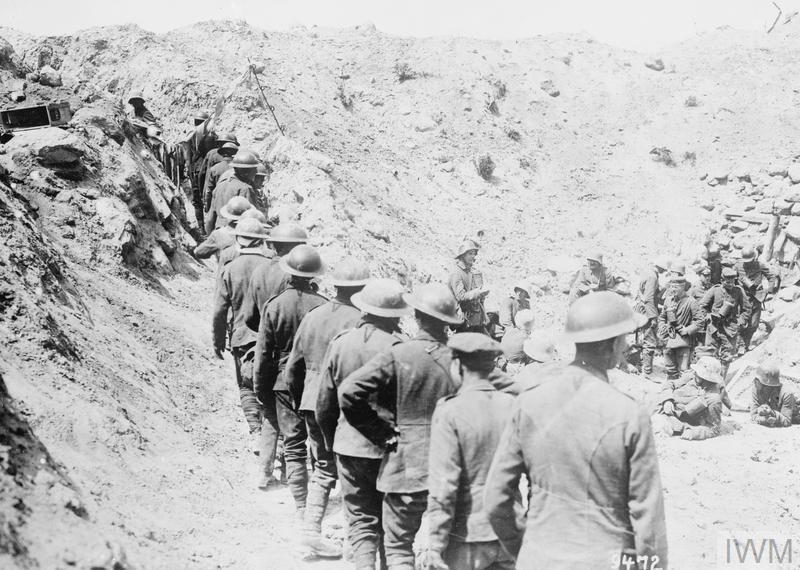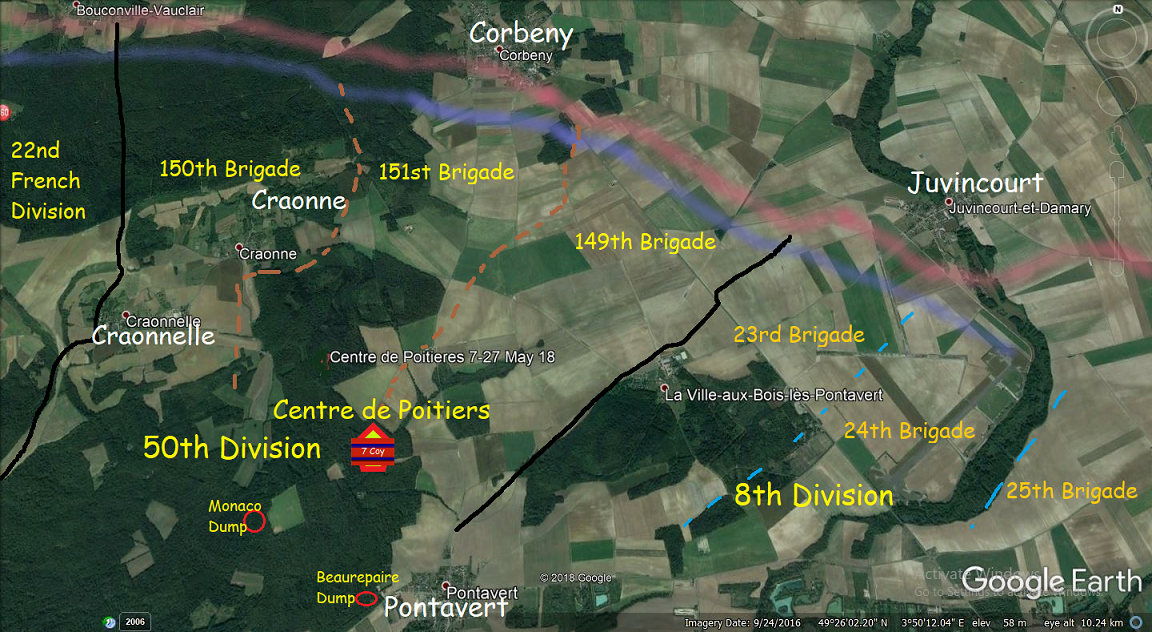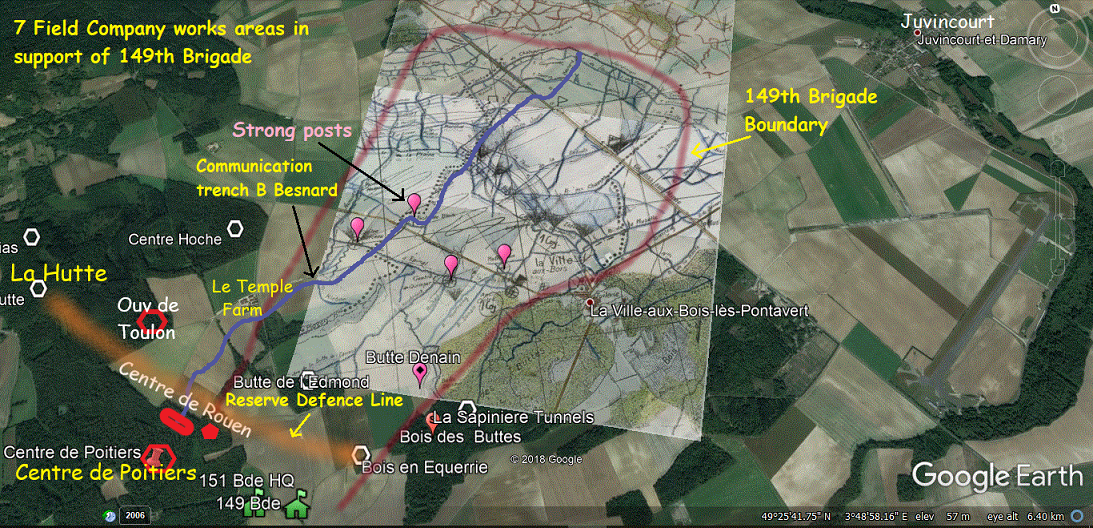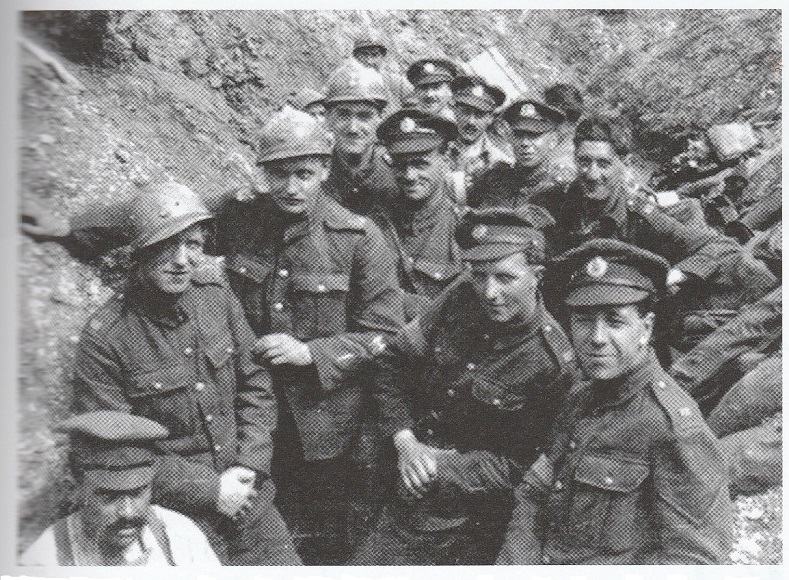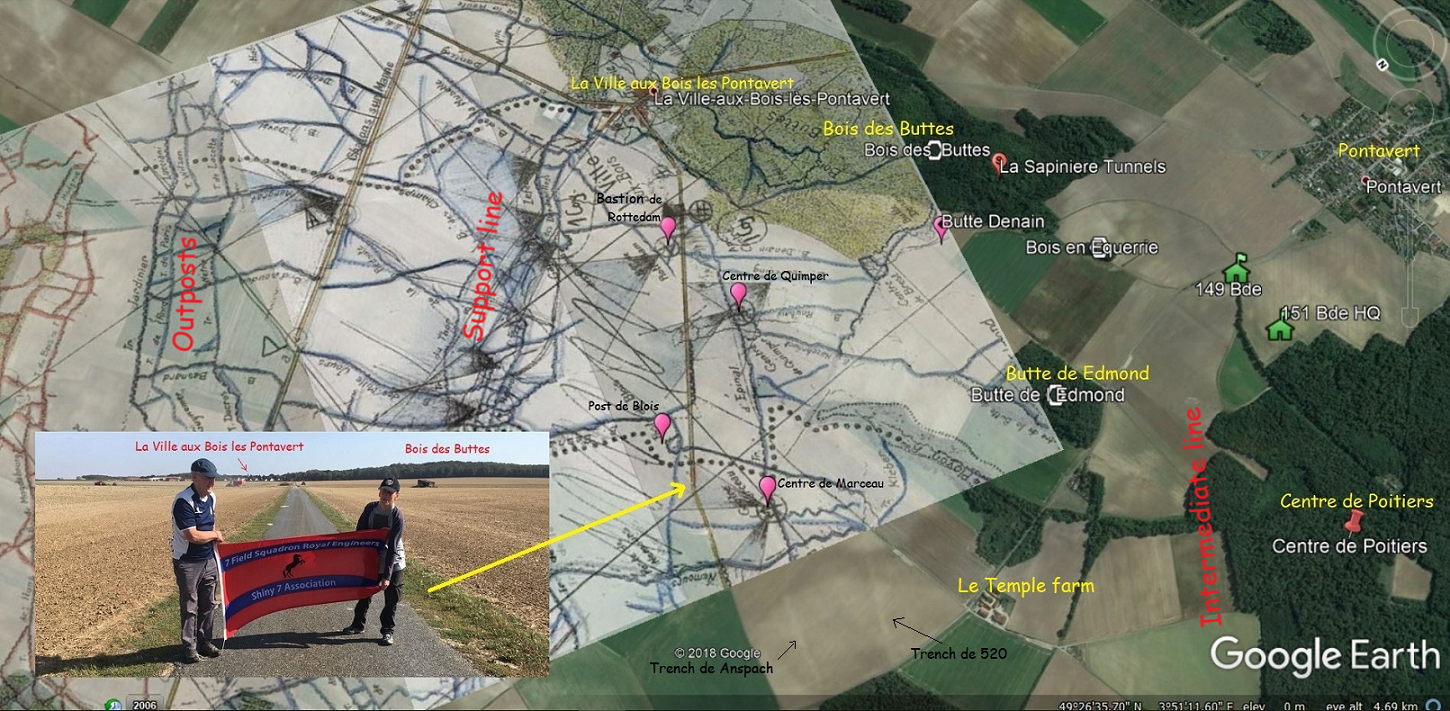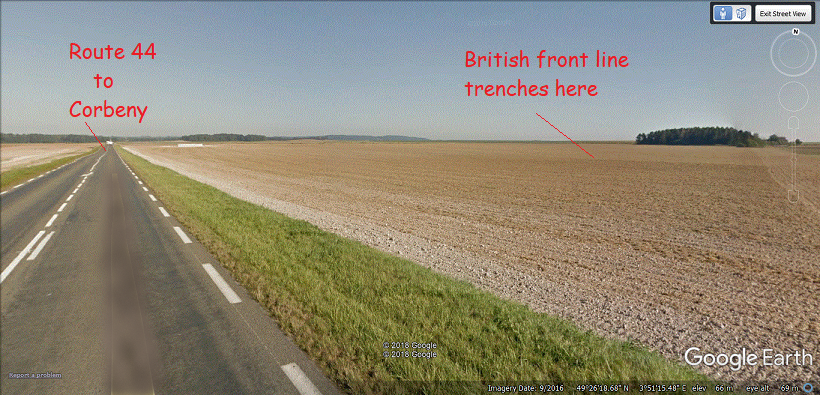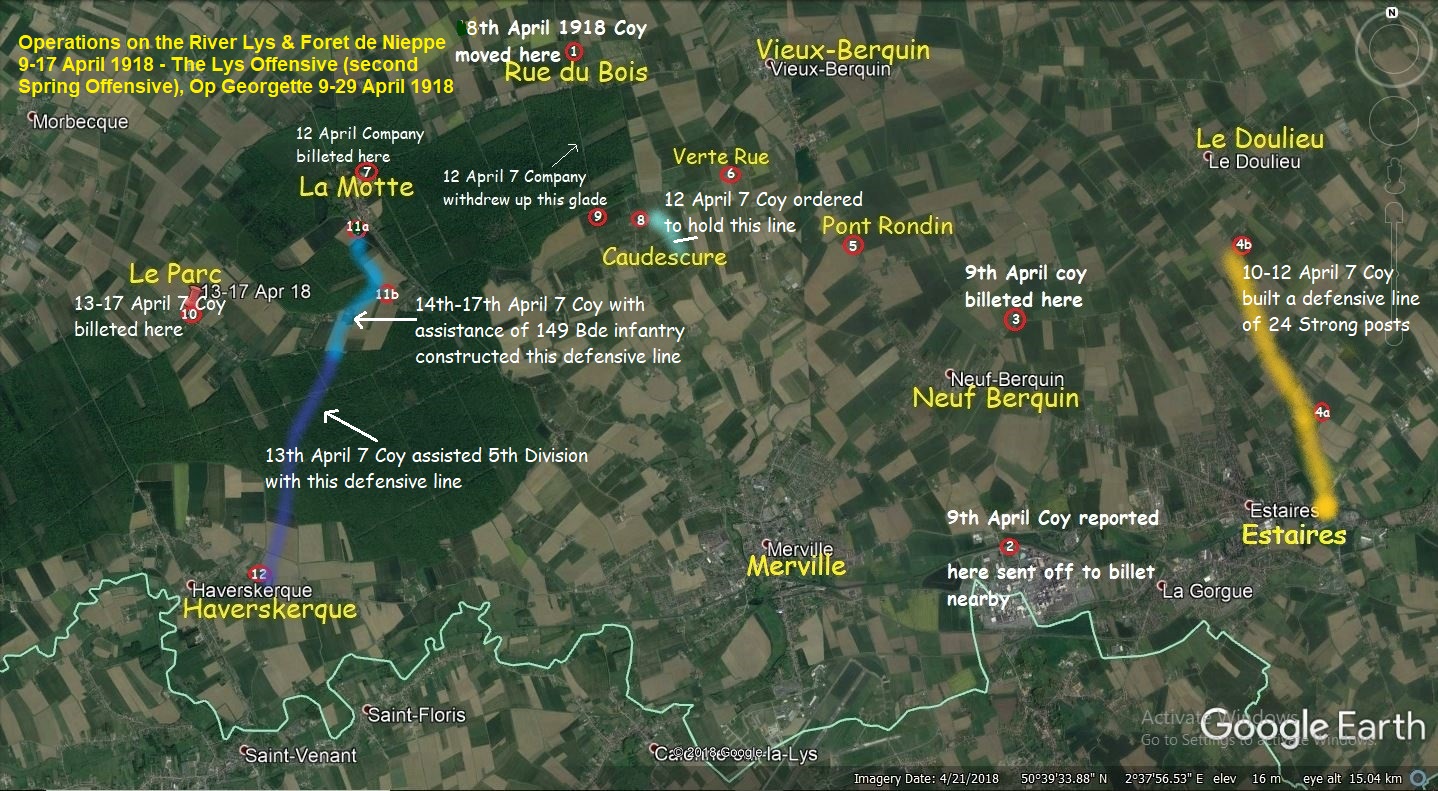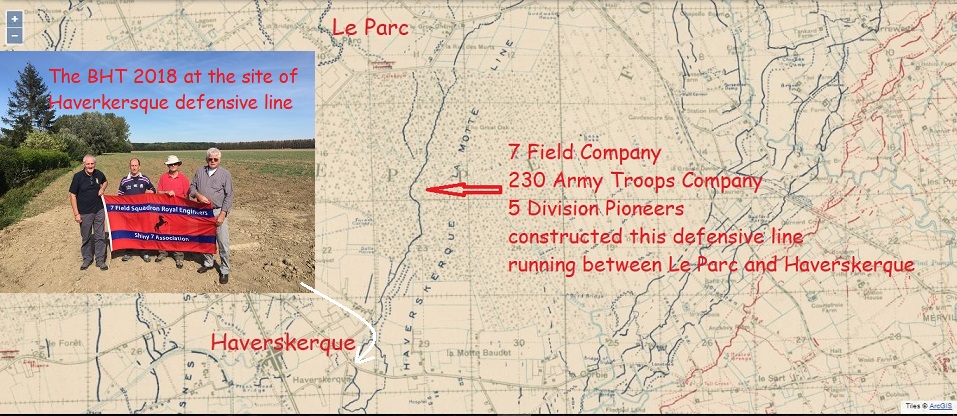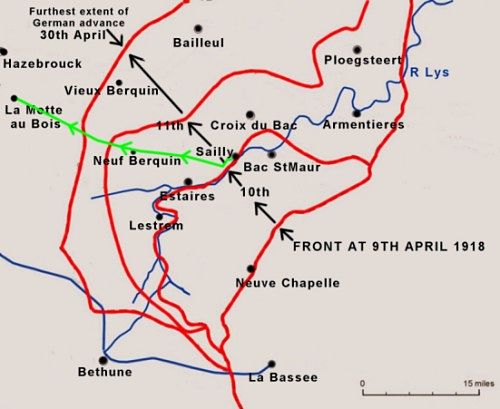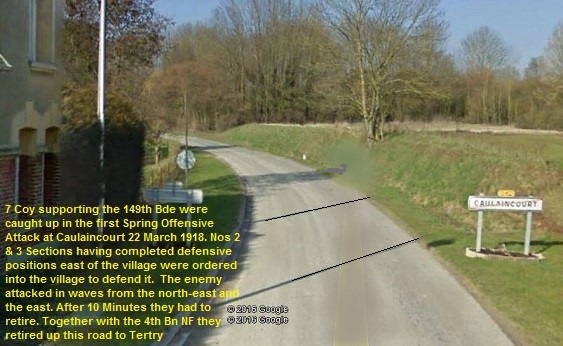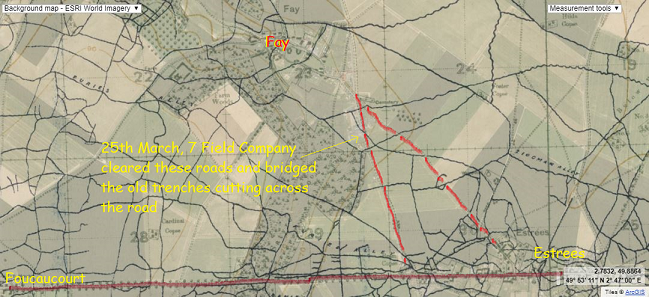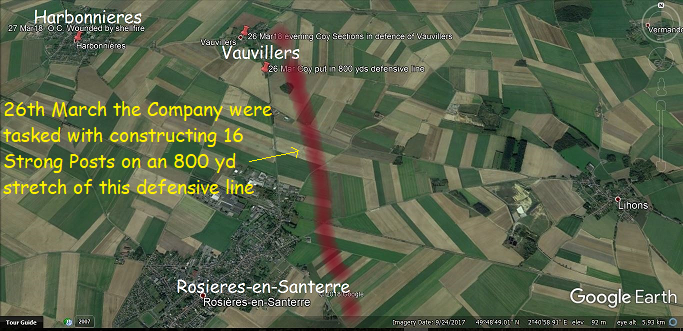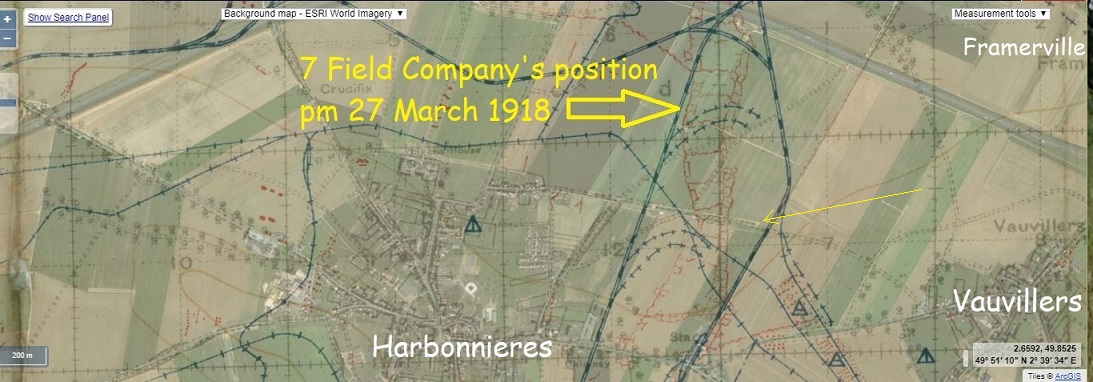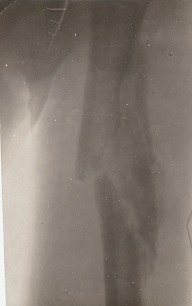7 Field Company Royal Engineers War Diary 1918 - 1919
King George V, Royal Engineer Cap Badges worn during this period
The Company was known as
The Black Horse during this period
War Diary 1918
7 Field Company RE War Diary 1918-1919 source; The National Archives, Kew, TW9 4DU
Into Battle - John Glubb
History of 7 Field Company at War - H.A.Baker
7 Field Company RE, War Diary in blue text
Capt Glubb MC, diary in black text
Capt Baker MC, diary in Brown text
Ypres I.1.d.3.6.
1-5 January 1918: Work on trench board track to Passchendaele continued by 1 & 2 Sections, assisted by 175 men working party on 1st and 3rd. Owing to parties for 4th being cancelled at short notice, trench boards had to be left 150 yds short of destination (circuit in Passchendaele)
work handed over to 222 Field Coy RE, 33 Div on the 5th. Work on Haalen switch continued by Nos 1 & 2 Sections. Nos 2,3,4,5 Posts each proceeded with 4 Splinter proofs for 4 men. - Nos 4 & 5 Posts partially dug. - Work handed over on the 4th to 222 Fd Coy RE. Observation Post for Artillery commenced in Passchendaele but slow progress owing to lack of materials. - During this period 1 N.C.O attached to Bde in line to supervise using of Abraham Heights Switch. About 1/2 of these were completed.
5 January: Maj Mcqueen returned from leave taking over command from Capt Baker MC. Dismounted Section moved by bus from Ypres to Eecke (4 mile S of Steenvoorde), mounted Section proceeding by march route.
6 - 15 January 1918: During this period certain training (drills, route march, reconnaissance lectures). Then carried out with No 3 Section (returned from hutting under C.E VIII Corps at Bailleul on 9th). No 4 Section and about 1/2 of No 1 Section -- RE HQ remained at Ypres as Steenvoorde was badly off for repairs, camp and billets sanitation necessities, it was necessary to arrange for supply of RE stores from Corps Dump, Oakhanger (near Poperinghe), and also to carry out repairs to minor works in Div area. - For this purpose No 2 Section (Lt Rebbeck M.C) was moved to Steenvorde on 8th, returning to Eecke on 14th. - Various work carried out included section of 16 Nissen huts for 176 Siege Battery R.G.A. in Steenvoorde, repairs to baths in Steenvoorde and Winnizeele, fixing missing points boards, erection of Nissens for Commandant Eecke, 2 Nissens huts for the commandant Winnizeele, marking shell holes for wiring practices for 151 Bde, supply of RE material and target material to Div. Hard frost throughout this period.
Ypres- 15-21 January 1918: Coy returned to Ypres on 15th.(dismounted Sections and Coy HQ by train to Poperinghe and march route, Mounted Section by march route in relief of 446 Field Coy RE who rejoined Div in Steenvoorde area on 17th. On 17th, Coy commenced work on Army Battle Zone, Corps line East of Ypres the work consisted of cutting drains to all links of trenches joining Low Farm Keep, Plum Keep, Vampire Keep, Square Farm Keep, Posts 1 to 15. - For this purpose, working parties averaging 250 - 400 were attached About 1800 yds of drains of the middle Section 8' wide at top and 1' at bottom, 3'6" deep with 2'6" berms. Work continued on 17th,18th,19th,20th during which period about 1150 yds of such drains were completed, remaining drains traced. 200 yds of tramway formation made and various works such as marking gaps in wire etc.
Wizernes
22-28 January 1918: On 20th orders received for Mounted Sections to proceed by march route in 3 stages to Wizernes (in Tilques area). Coy HQ and dismounted Section by train on 21st. On arrival in Wizernes Nos 1 and 4 Sections were despatched on 21st to work on VIII Corps Musketery School at Noritersecourt (hutting etc) rejoining Coy HQ at Wizernes on the 27th.
Ypres
29-31 January 1918: On 26th, O.C. & Lt Baldwin proceeded to Ypres to take over work from 222 Field Coy RE in Passchendaele Sector. - Coy returned to previous billets in Ypres on 28th. Work was commenced on 29th without infantry works parties, also on 30th. - On 31st working parties up to 150 men were attached. - Work in hand as follows: Maintenance of 3 miles of Duckboard track, Completion of Duckboard track to Passchendaele, laying of wire mesh on Trenchboard tracks, continuing work on Posts 2,3,4,5 in Haalen Switch, work on O.P. in Passchendaele, assistance to 149 Brigade (in line) on wiring. Sections got to work on 31st
4-5 February 1918: No 1 Section went into advanced billets in tunnel system at Crest Farm for work on Coy H.Q. Passchendaele. This work consisted in opening a second entrance to the existing mined dugout. The artillery O.P. Passchendaele was completed on night 5-6/2/18. The job consisted of clearing two adjacent small cellars, strutting the walls & roofs and inserting a 6' 6" periscope through the debris covering the smaller cellar
6 February 1918: Lt Col J.A. Mcqueen DSO. MC. RE, left the Company to assume command 50th Divisional RE 6/2/18. Capt H.A Baker MC.RE assumed command of the Company
8 February 1918: Handed over works to 446 Field Coy RE. and took over sector on right, the new work lying in the area enclosed by the Broodseinde - Passchendaele road, the Zonnebeke - Broodseinde Road and the Ypres - Roulers railway. Distribution of Sections, No 1 remained at Crest Farm, No2 employed on Reserve and Support Line Posts.
No 3 started work on a ferro - concrete T.M emplacement at P.17.c.3.8. for two 6" T.Ms. No 4 remained on Corps Dressing Station, Ypres.
9 February 1918: Capt Baker left to attend Company commanders course at the RE School, Blendecques. Lt Baldwin took over temporary command of the Company.
10 February 1918: Lt Haywood-Davis RE. was transferred to 351st E&M Coy RE.
11-18 February 1918: No 1 Section returned from Crest Farm and relieved No 4 at Corps Dressing Station on 12/2/18. No 4 commenced work on Duckboard tracks from Daring Crossing D.16.d.7.2. - D.23.a.4.7 and Alma D.22.a.4.6.- Zonnebeke Track at D.22.c.9.7. These tracks were completed by the 16/2/18. Lt H.A.Benson RE arrived as a reinforcement and took over command of No 4 Section commenced work on Reserve Line Posts.
19-22 February 1918: Work was continued up to 22nd when all uncompleted work were handed over to 212 Field Coy RE. of the 33rd Division. The Corps Dressing Station at Ypres was completed on this date. On the 21st the Coy transport less 1 GS wagon, 1 water cart and riders proceeded by road to rest area, attached to transport of the 149 Inf Brigade.
23 February 1918: Dismounted personnel and remaining horse transport were attached to 149th Bde group for move.
am. Dismounted personnel entrained at Brandhoek at 10.50am. 1 GS wagon 1 water cart and 6 riders entrained at Vlamertinghe at 12.50pm. Blankets etc came direct by lorry under Brigade arrangements from Ypres to Cormette in rest area.
pm. 7 Field Company detrained at Wizernes and marched to Cormette. Q.54.c (SH 27 SE) Horse transport arriving by road, arrived the same day.
Cormette
24-28 February 1918: 25/2/18 Sections 2 and 3 marched to Nortbicourt to work on Fifth Army Musketry School. The remainder of the Company commenced training, special attention being paid to drill and smart turnout. During month the following awards were notified:
6/2/18 No 22435 Spr W. Abbott awarded Belgium Croix de Guerre
11/2/18 No 24914 Cpl J Bates Mentioned in Dispatches. Authority London Gazette.
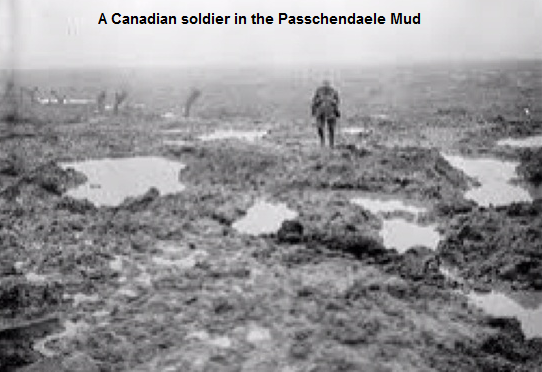
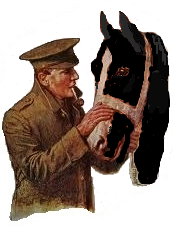
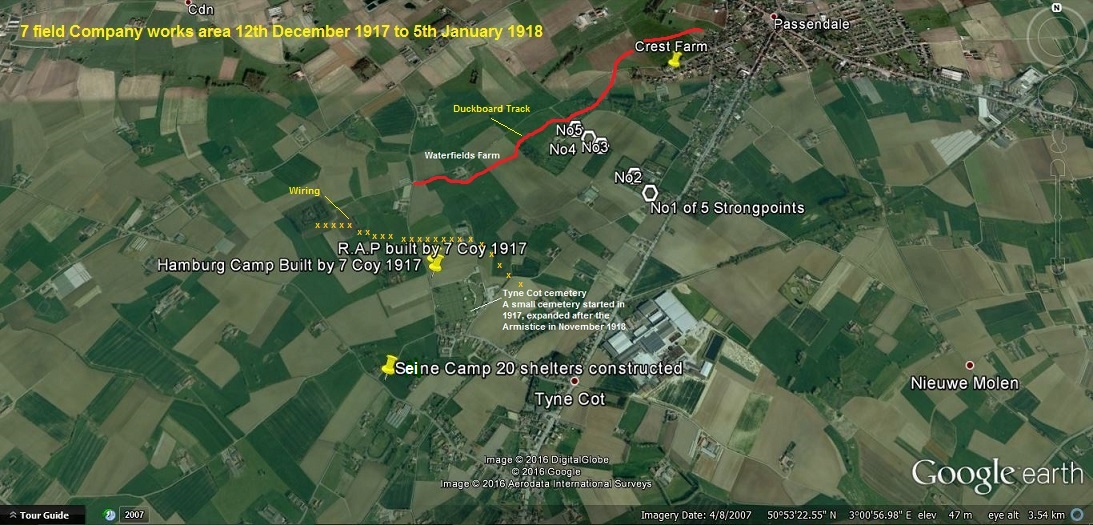
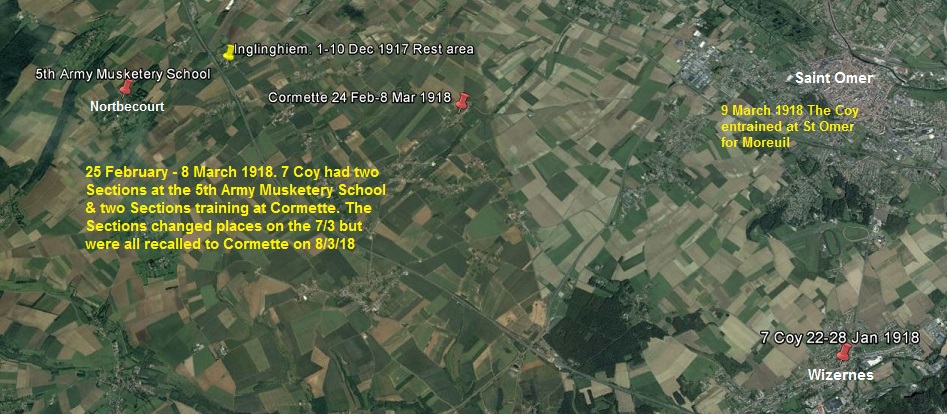
Cormette
1-8 March 1918: At the beginning of the month the Company was distributed as follows: 2 & 3 Sections working at Fifth Army Musketry School, Norbicourt. 1 and 4 Sections at Headquarters in training at Cormette. On the 7/3/1918, Nos 2 & 3 Sections were relieved at Norbicourt by Sections 1 & 4 rejoining Headquarters on the same day.
On 8/3/18 Nos 1 & 4 Sections were recalled Cormette
9 March 1918: 7 Field Coy moved, entraining at St Omer at 12 noon.
10 March 1918: Detrained at Moreuil at about 1am and marched to Castel
Fresnoy en Chausse
11-15 March 1918: Marched from Castel to Fresnoy en Chaussee
arriving about 1pm. Period 11th -15th employed on Company training.
Monchy Legache
16-21 March 1918: Moved by bus from Fresnoy en Chaussee to Monchy Lagache. Here the Coy was employed on the defences of the neighbourhood of Tertry.
22-23 March 1918: on the 22nd, Sections 2 & 3 moved up to Tertry for work,the O.C., Major H.A Baker accompanying them. They were to be employed here on defences under 149th Infantry Brigade. At 3pm work was commenced on Battle trenches north east of Caulaincourt. The work was completed by 5pm, and the half Company withdrew to Caulaincourt where they received orders to hold the village against a threatened attack by enemy cavalry. At 6.15pm the enemy infantry attacked, in waves from the north east, and by skirmishes through Lake Wood to the east of the village. At 6.25 pm the troops holding the line on the right of the half Company gave way, followed by those on the north of the village. The half Company, together with such infantry as were in the village, then withdrew following a party of the 4th Northumberland Fusiliers and retired along the road, leading north west out of Caulaincourt. Enemy snipers entered the village and caused several casualties the half Company lost 2nd Lt H.A.Benson wounded and five other ranks. The two Sections reformed at Tertry under Major Baker and acting under instructions from 149 Bde, dug in and held a series of posts on the bank of the river Omignon, east of Tertry, where they remained until 2.45 am having received orders from the Brigade at 2 am to bring up the rear of the 5th Northumberland Fusiliers and act as a Flank guard as far as Meraucourt, after which the two sections were ordered to rejoin the rest of the Company at Mons en Chaussee. During this time the O.C. disposed the infantry in the new line in front of Monchy Lagache and Douvieux.
The half Company left at Monchy Lagache on morning of 22nd remained there until orders arrived from Major Baker to move to the neighbourhood of Mons en Chaussee at once.
Transport and 1 & 3 Sections moved off at about 9. pm and reached Mons en Chaussee where they remained in bivouac for the night. Part of No 3 Section joined in the early morning, but the main body of the two forward sections did not reach the Company before it moved off again.
Mons en Chaussee
23 March 1918: At 6.45 am orders arrived from the C.R.E to cross the Somme at Brie and proceed to Villers Carbonnel. The O.C joined as the Company was moving off at 7.15 am
a guide was left to bring on such of Sections 2 & 3 as had not rejoined. The Company reached Villers Carbonnel about 1.30 pm and remained until 4.30 pm. While at this place enemy aeroplanes came over and used their machine guns upon the troops in the neighbourhood. They were fired upon and two brought down. One driver in the 7 Field Coy was wounded.
24 March 1918: The Company then marched to the neighbourhood of Berny en Santerre arriving about 6 pm. At 10 pm orders arrived from C.R.E and the Company marched to Foucaucourt arriving at 2 am.
25 March 1918: On the afternoon of the 25th the Company was employed on clearing the road running north out of the Estrees Foucaucourt road to Fay and bridging trenches cut across the roads. At 9.30 pm the HQ Transport was moved back to Harbonnieres, the section transport been left to wait for the dismounted sections at Foucaucourt.
26 March 1918: These sections on completion of the work on roads held Fay until 12 midnight, without being attacked and then moved back and commenced work on a defence line running in front of Vauvillers and Rosieres-en-Santerre, the Company being employed on a stretch 800 yards long on either side of the Harbonnieres - Lihons road.
pm: Work was completed and the Company moved off at 3pm to a farm south of Vauvillers and there received orders to hold Vauvillers against a possible attack from the direction of Framerville. Remained here until 6 pm and then marched to Wiencourt where they passed the night. The HQ Transport moved from Harbonnieres at 4 pm for Aubercourt.
27 March 1918: At 8 am on 27th the dismounted sections at Wiencourt paraded and marched out to form a defensive flank about a mile north west of Rosieres. This portion was held from 10 am - 12 noon without fighting. They then concentrated at Harbonnieres where the O.C., Major Baker was wounded by shell fire. Acting under direct orders from the C.R.E. the Company formed up north of Harbonnieres and attacked in an easterly direction, obtaining there objective the line of the Proyat - Rosieres railway, and then remained in the captured -
28 March 1918: trenches until 4 am of the 28th when they received orders to fade away. They then marched to a position slightly to the north of Caix west of the Caix- Harbonnieres Road. This position was occupied from 7 am - 4 pm and the Company was then withdrawn, loosing 10 O.Rs in withdrawing, and were sent by C.R.E to Beaucourt.
HQ Transport remained at Aubercourt until 2 pm the 28th and then marched to Beaucourt, having picked up the section transport before leaving. At Beaucourt an open order was received ordering all transport back behind the Boves - Moreuil Line, and the transport marched for Moreuil in company with the 447th Field Coy transport. At Moreuil orders were received from C.R.E for transport to meet dismounted sections at Castel.
Castel
29 March 1918: am. Company concentrated at Castel at 3 am 29/3/18. HQ transport was moved to Boves during the morning
Boves. pm. Dismounted sections stood by at Castel for work until 6 pm when they rejoined transport at Boves.
30 March 1918: The whole Company left Boves at 10.15 am and marched to Sains-en-Amienios. Small parties of sappers were detailed during the afternoon to keep part of the Boves-Sains road open and the traffic moving.
31 March 1918: Company received orders to move with 149 Inf Brigade Group. Transport went by road to Bourdon. Dismounted personnel proceeded to Saleux to entrain for Rue.
Ponches
1 April 1918: Dismounted personnel entrained at Saleux at 6 am, detrained at Rue at 12 noon and marched to Ponches where the Company was
2 April 1918: billeted. Transport arrived at Ponches having marched by road.
Move to east of Amiens (23 February to 20 March 1918) By Capt H.A. Baker MC
The 50th Division was relieved on the Passchendaele sector by the 23 Division on the 23rd February, and moved to the Wizernes area south of St. Omer where it formed part of G.H.Q. Reserve. Two sections of the 7th Company were detached on 1st March for work on the 5th Army Musketry School at Nortbecourt. On the 10th March the Division moved to the area about Moreuil on the River Avre, 12 miles south west of Amiens. The 7th Company entrained at St. Omer at noon, detrained at Moreuil at 1. Am on the 11th and marched to Fresnoy-en-Chausee, where it remained till the 16th, when it moved by bus to Monchy Lagache (24 mile) for work under the C.R.E. XIX Corps Troops, with working parties of Italians on the ‘’Green Line’’ defences in the neighbourhood of Tetry. This was the most retired reserve line in the 5th Army area and was only partially excavated and wired. The Company was so employed until the 21st of March when the 50th Division was moved hurriedly up to occupy these defences which formed part of the Perrone Bridgehead.


Below: 22 March 1918, Nos 2 & 3 Sections retired up this road from Caulaincourt under fire from the enemy.
Casualties:
Killed:40355 2nd Cpl Reid.
Wounded: Lt H.A. Benson,
22445 Serjt J.Farrer MM (later DOW),(see photo)
169655 Spr T.J. Coldbeck (later DOW),
134249 Spr S. Johnston (later DOW)
Missing believed dead:
26408 Spr A Richmond
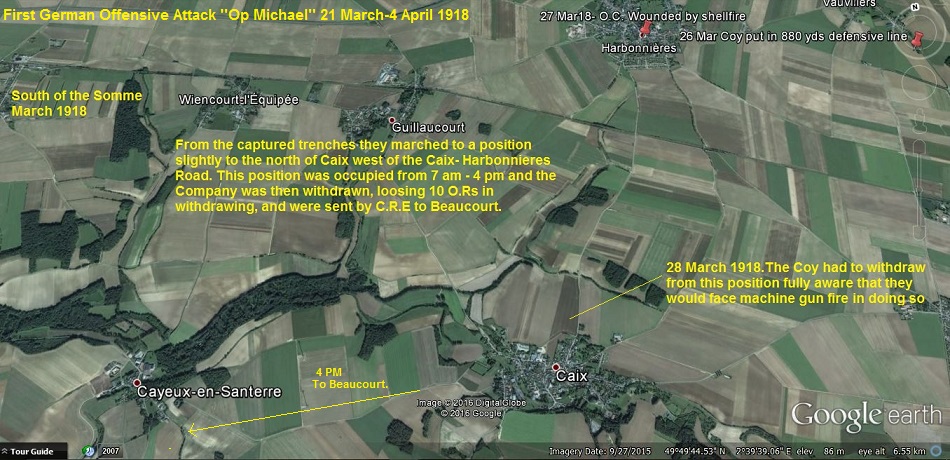
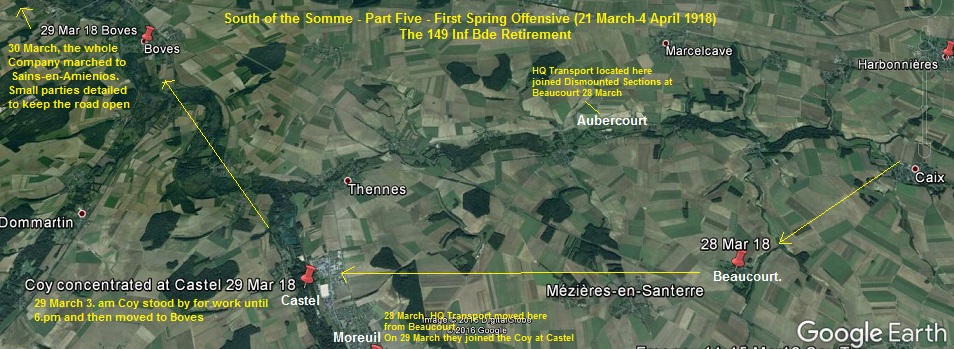
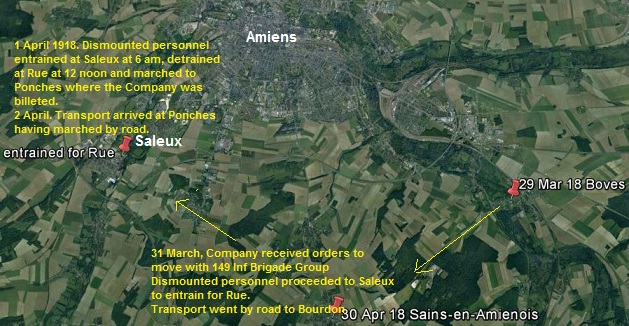
The H.Q. Transport went back to Harbonnieres. The dismounted sections held Fay until midnight when orders were received to proceed to Vauvillers (7 m) for the construction of a chain of defensive posts running north and south to the east of the Framerville- Vauvillers-Rosieres road. During the 25th the O.C.had to cover so much ground on reconnaissance he worked three horses to a standstill. During this part of the retreat the Company morale was exceptionally high and a very fine spirit was shown by all ranks in the face of much hardship.The Company, when falling in to march off on one occasion at short notice, was compared by a staff officer to a company of guards. The value of mouth organs and singing on the march was very clearly demonstrated, as was the value of all the training in march discipline instigated by the late O.C. Sixteen platoon posts were commenced at 9.am. on the 26th, the Company being assisted by a labour battalion. Work was completed about 12 noon and occupied at once by retiring infantry which, greatly reduced in strength, was able to reform and fight on this line until forced to retire by out flanking movements on the night of the 27th/28th. On completion of this work the three engineer companies were withdrawn under the C.R.E.to a position imediately north west of Vauvillers, where they formed a retired left flank guard to the infantry holding the newly dug position. From the 7th Company’s position small bodies of the enemy’s infantry were seen at a distance of two miles working down the main Foucaucourt - Villers-Bretonneux road and also advancing on Framerville. Information was at once given to D.H.Q. at Vauvillers. The G.O.C. 50th Division (T/Maj-Gen H.C.Jackson D.S.O.) immediately organised a counter- attack on Framerville by the infantry to hand and with G.S.O.I (Lieut-Colonel Anstey D.S.O.)- both mounted- accompanied the attack, which succeeded in capturing Framerville and driving the enemy back some distance.The left flank being thus established the field companies were withdrawn by 6.pm to Wiencourt ( 4 mile), where the tired sappers who had been marching and working, with some fighting, for five days with little rest were left undisturbed till
5.am. At dawn on the 27th a composite battalion was formed near Wiencourt, under command of the C.R.E. consisting of the 7th Company RE, 447th Company RE and 350 infantry details of the
151st Brigade and other formations. As these details belonged to many regiments and contained no formed units and only junior officers, they hastily organised into eight platoons and two
companies, one company being placed under the O.C. 7 Field Company and one company under the O.C. 447 Field Company.
The Somme Retreat 21st to 31st March 1918 By Capt H.A. Baker MC
The great German attack on the 4th and 5th Armies commenced at dawn on the 21st March, as had been expected for some days. Much aided by thick mists, which just suited the new infiltration tactics of the Germans, it progressed rapidly on the thinly held front of the 5th Army. The 50th Division, forming part of the G.H.Q. reserve, was pushed up by train and march route to the neighbourhood Beaumetz and, during the night of 21st/22nd proceeded to occupy the incomplete ‘’Brown Line,’’ which was here only spitlocked 6’’ deep and thinly wired. The 7th Company was affiliated to 49th Brigade temporarily (H.Q. Tertry) with orders to keep two sections in reserve at C.R.E.s disposal. At 3.pm 2 and 3 Sections went up to assist the infantry in improving their defences in the Brown Line north-east of Caulaincourt. The enemy could already be seen advancing in the distance, but the work was completed by 5.pm, and the half Company withdrew to Caulaincourt, where they received orders from the infantry commander on the spot to hold the village against a threatened attack by enemy cavalry. At 6.15 pm the enemy infantry attacked from the north east and the east. At 6.25. the troops holding the line on the right and in the north of the village were forced back and the half-company was obliged to retire in conformity. As the Company left the village, enemy snipers entered and caused several casualties, including 2nd Lieut H.A.Benson, Serjt J. Farrer M.M., and four sappers. On arriving at Tertry they were reformed under major Baker and by order of the B.G. commanding 149th Bde, dug and held a series of posts on the bank of the River Omignon, covering the east of Tertry. Brigade H.Q. turned out every man for the defence of H.Q. but no attack developed. At 2.am on the 23rd, orders were received from Brigade to form a flank guard in rear of 5th Northumberland Fusiliers as far as Merancourt, starting at 2.45.am., after which the two sections were to join the remainder of the Company, which had proceeded to Mons-ens-Chausee with the transport earlier on the 22nd, in case they should be required for demolition of bridges over the Somme. During the night 22nd/23rd major Baker was instructed to guide the Brigade to trenches of the Green Line, unfortunately the sector they were to occupy was that next to where the Company had been working and was not complete. In this sector these defences had hardly been commenced. As the night was pitch dark it was very difficult to find anything except an old German trench which ran roughly parallel to the desired position. At 6.45.am on the 23rd, orders arrived from the C.R.E. to cross the Somme at Brie, and to proceed to Villers Carbonnel. The bridges here had been prepared for demolition and were to be demolished by the Army Troops companies who had prepared them. The O.C. rejoined the company as they were moving off and a guide was left to bring up the remaining two sections which had not yet rejoined. The Company remained at Villers Carbonnel 1.30 to 4.30.pm. Whilst at this place and surrounded by troops resting each side of the road, three enemy aeroplanes flew low over the crowded fields. One driver was hit in the leg. All troops in the neighbourhood loosed off at the aeroplanes and two of them never pulled out of their dive and were destroyed. It is perhaps, too much to claim that the 7th Company brought them down but they may have done.
The Company then marched to Berny-en-Santerre arriving 6.pm. (3 mile), and had no sooner pitched its bivouacs than it was ordered to move again to Foucaucourt (5 m) where it was employed during the 25th in improving communications in the neighbourhood of Fay and Estrees and and bridging trenches to facilitate passage of transport and gun limbers.
The composite battalion was thus about 500 strong, organised in two similar wings, each wing consisting of an engineer company (about 80 rifles) and an infantry company (about 160 rifles) with a small improvised headquarters section of cyclist and runners. The ‘’Battalion’’ left Wiencourt at 7.am., with instructions to take up a position to the right flank and rear of the reduced 149th Brigade, then holding the southern portion of the Vauvillers- Rosieres ‘’line’’, an enemy attack through Rosieres being anticipated.
The right wing, under Major Baker, took up a position immediately north -east of Rosieres, covering the exits from that village, the left wing under Major Chivers being held in reserve in the railway cutting one mile in the rear. No attack developed on this flank and about 12 noon orders were received for the Battalion to be withdrawn rapidly to co-operate with two battalions of the 8th Division in a counter-attack on the village of Proyat, from a line Bayonvillers-Harbonnvieres.
The left wing under Major Chivers was at once marched north-east through Harbonnieres, that under Major Baker instructed to follow. On arrival of the left wing at Harbonnieres the enemy infantry could be seen advancing in successive lines south-east from Proyat over the open country. This wing was directed to proceed up a valley, hidden from the enemy and to seize and hold a wood one mile to the north-east whose western face appeared to command the main road to Villers- Bretonneux and the whole line of the enemy’s advance. It reached its position with about 10 minutes in hand and the advanced enemy lines, checked, and lay down and remained inactive. About this time the left (7th Company) wing emerged through Harbonnieres, which was being shelled, and here Major Baker was severely wounded in the left arm and had to be evacuated, the command devolving on A./Capt Baldwin D.C.M. The platoons of this wing, under Lt Pottle, were formed up under desultory field gun fire and directed to advance in the direction of Framerviller, extending in open formation when under rifle fire, with their left flank in touch with the right of the wing under Major Chivers. At the same time a battalion of the 8th Division debouched from Bayonvillers and moved to the northern flank. The enemy, on seeing troops advancing from Harbonnieres, commenced to retire slowly over the open ground towards Proyart. The Composite Battalion advanced about 2000 yards in open order in successive lines, suffering a few casualties from machine-guns and rifle fire. About 5.pm the enemy’s fire increased, mainly from machine-guns in old trenches about 400 yards from the advance attacking troops, which, having no artillery or machine gun support, were held up about 1,000 yards south-east of Proyart.
As dusk was falling and a good position for maintenance against counter-attack, namely an old trench system running north and south across the German line of advance, had been reached, the Composite Battalion was disposed in these trenches with a view to holding the ground already gained. The 7th Company was on the right and in touch with troops in the neighbourhood of Framerville. At this time Major Chivers, commanding the left wing, was severely wounded by machine-gun bullets at close range. The enemy’s advance south of the Somme appeared to have been checked, with prospect of a successful defence being put up through the night and the following day. It was believed that the gap of 1.½ miles between the River Somme and the main Villers - Bretonneux road was filled with troops of another division. The situation on the immediate front of the Composite Battalion was reported to advanced Div.H.Q. At Harbonnieres as being favourable and a party sent back for more ammunition and rations. During the night the G.O.C. 5oth Division visited the position and expressed his satisfaction with the manner in which the field companies and infantry details had operated during the day and commented on the good disposition and general alertness of the engineer outposts and sentry groups. At 4.20 am, however, the G.SO.2, 50th Division arrived with information that the enemy had succeeded during the night in passing between the river Somme and the Northern flank of the Composite Battalion and troops on its left, and was now advancing in strength on Bayonvillers from the direction of Morcourt, and the northern flanking troops were already being withdrawn. The C.R.E. was further directed to withdraw the Composite Battalion at once, before daylight, if possible, behind Harbonnieres and thence to retire southwards Caix, to which place the remainder of the 50th Division was also being withdrawn. As dawn was then breaking no time was to be lost in crossing the 1.½ miles of open ground to Harbonnieres if heavy casualties were to be avoided. Withdrawal was effected in an orderly manner from the left and without casualties. The German scouts followed close after, one being captured. The troops on the right of the 7th Company were not so fortunate and lost heavily in their retirement across the open. The sections and platoons of the Composite Battalion as a consequence entered Harbonnieres somewhat mixed up and not in regular formation. The officers with the leading platoons commenced to reform their commands as previously ordered under cover of the village when G.S.O.1 (in the absence of the C.R.E. who had not yet reached Harbonnieres) ordered the retirement to be continued at once to Caix (2.½ miles to the south) without first reforming. As the 50th Division troops from Vauvillers was also now retiring along this road. The infantry details of the Composite Battalion became merged with them and not readily distinguishable owing to identity of units, with the result that it was only possible, on reaching Caix, to extricate the field companies (7th and 447th) and portions of the infantry platoons. D.H.Q’s intention was that the Composite Battalion should, on reaching Caix, reform and advance again 1.½ miles northwards and take up a position covering the exits of Guillaucourt. This was now recognised to be impracticable in the time available. It was therefore, decided that the infantry details should rejoin their units forming part of the composite infantry brigade already assembled under Brigadier Liddell D.S.O., with whom the C.R.E. and two field companies, together with the 7th D.L.I. Pioneers were directed to co-operate on holding the rising ground on the north bank of the River de Luce covering the village of Caix. Certain French territorial details were on the right flank of the composite infantry brigade, the 7th and 447th field companies on its left, with the 7th D.L.I. on the outer left flank. The transport of the engineer companies having to retire during the night from Wiencourt, through Marcel Cave on Aubercourt, the sappers were without any form of entrenching tool, but managed in the absence of any natural cover to make small rifle pits with their bayonets. A narrow valley crossed the front of the position with small woods on the far side. It was not possible to deny these woods to the enemy who occupied them about 2. pm, but remained inactive except for desultory fire from light trench mortars till about 3.30.pm, when effective machine-gun fire was opened. By the same hour enemy machine-gun detachments (well handled as usual) had succeeded in working well round the left flank of the 7th D.L.I. and in enfilading the whole position from the wooded high ground south-west of Guillaucourt. The withdrawal of the Composite Brigade through Caix and across the River de Luce was ordered. This entailed retiring over some 200 yards under machine-gun and rifle fire at close range, the 7th Company suffering about 12 casualties in the operation- casualties which appeared few under the circumstances. Amongst those Serjt P. Cheal M.M. who was severely wounded. This N.C.O. had performed consistently good and gallant work since coming out with the Company in August, 1914. On the Composite Brigade taking up a fresh position south of the River de Luce the two field companies were direct to rejoin their first line transport at Beaucourt south west of Caix, with a view to resuming their normal engineer duties. Owing to the enemy’s continued outflanking movements from the north, the Composite Brigade (representing the whole of the remaining strength of the Division) was retired through Beaucourt the same evening (28th/29th) and thence northwest across the River de Luce at Domart to take up a strong position about Gentelles, facing east. The field companies were consequently directed to Castel on the River Avre during the night 28th/29th, and to Boves on the evening of the 29th, where an engineer reconnaissance of bridges and crossings over the River Avre was made as a precautionary measure. The Division was in action on the 29th on the Gentelles position- the last position covering Amiens, about six miles distant. On this day reinforcements arrived to secure the flanks,and the enemy, faced at last with the necessity of frontal attack and suffering doubtless from fatigue, confusion and shortness of supplies, was unable to make any further progress. On the 30th the Division was relieved and withdrawn over the River Avre after nine days of continuous open fighting with isolated or insecure flanks. Its casualties during this period were very heavy. The 7th Company marched to Sains-en-Amienois (4 mile) on the 30th and to Saleux (6 mile) on the 31st entrainment to Rue, whence it marched on the 1st April to billets at Ponches, near Crecy, and remained there four days. The Company’s casualties during the nine days (21st to 29th March) amounted to 21, namely 4 O.R.s killed, 2 officers and 15 O.R.s wounded.The latter included 3 section Serjeants A. Farrer M.M., F. Wadkinson, P.Cheale M.M. A./Capt H.A.Baker M.C. severely wounded on the 27th, had served with the Company since the autumn 1915. He was succeeded by A./Capt W.F. Baldwin D.C.M., Croix de Guerre, who had joined the Company in January 1916. Lieut F.J. Slattery became A./Captain.
7 Coy casualties March 1918
Ponches
2 April 1918: billeted. Transport arrived at Ponches having marched by road.
3 April 1918: At 6.35 pm on the 3rd, 50 Div OO (Operations Order) No 141 was received, containing following points of importance:
1. The 50th Div is to be transferred from IV Army to I Army
2. Division will move by road as follows
a. Dismounted personnel by bus on the 4th instant
b. Transport by road staging tonight (3/4 April) in Willeman. Transport to start as soon after receipt of order as possible. Transport moved off at 8.45.pm.
4 April 1918: Dismounted personnel embussed at Ligescourt and proceeded to P.31.c (Ref sheet 36A) near Busnes debussed and marched to billets at Lenglet V22
(ref sht 36A)
5-7 April 1918: Training
8 April 1918: The Company marched complete with transport to new billets at Rue de Bois
9 April 1918: At 8.30 am received orders from 149 Bde to standby ready to move at one hours notice, this was confirmed by a note to the same effect from C.R.Es adjutant received at 8.45 am. At 9.20 am orders arrived from 149 Inf Bde to move and concentrate at L.26.d (sht 36A) south of the Merville - Estaires road. On arrival at rendezvous word was received from C.R.E. That Brigade movement order should have not included this unit, and instructing me to billet at the point of concentration if billets were available and if not to move to Neuf Berquin. Nearest billets were at Rue Provost L.8.d (sht 36A) where the Company remained for the night. The HQ Transport spent the night at Pont Rondin, about midway between Neuf Berquin and Vieux Berquin.
Rue Provost
10 April 1918: Despatched one section by C.R.Es orders to Vieux Berquin to unload and park the pontoons and bridging equipment of the Divisional C.R.E. At 3.30.pm orders arrived from the C.R.E. for the Company to move up to site and dig a line of posts running north east from in front of Neuf Berquin. Digging commenced at 7.30 pm and continued until 11 pm on a line some three thousand five hundred yards long, running in a north easterly direction from the Courant de la Meteran Becque almost due east of Neuf Berquin. This line consisted of a system of twenty four platoon posts dug as far as possible in ploughed land for concealment. Company billeted for the night in adjacent farms.
11 April 1918: Work was resumed at 5.30 am. At 8 am a platoon of the 7th D.L.I (pioneers) was received to reinforce the working party. At 9.30 am, infantry fell back on our left and would not halt on the line. The sergeant who attempted to stop them failed to ascertain their unit. The situation being very obscure, I thought well to man such posts as I could with forces at my disposal. With the pioneers and sappers I occupied the twelve posts on the right, continuing to work on the same. Reported situation as far as known to C.R.E. and 149 Inf Bde. About 10.30 am, infantry from various units from the 29th and 40th Divisions and the Fifthteenth Corps Entrenching Battalion arrived to man the line. I discovered at this time that the 29th Division had some posts dug about 300 yards in rear of my left flank, so while the infantry were occupying the line we had been working and employed sappers and pioneers on a switch line connecting our right flank with the left of the posts of the 29th Division.
The infantry from the 29th and 40th Divisions and the XV Corps Entrenching Battalion were withdrawn at about 1.pm. Received word from C.R.E that Division believed there were plenty of troops in front and we were to remain while we could do useful work. At 2.pm a half Company of RE of the 29th Div armed for digging. I showed them what had already been done and their officer agreed to inform C.R.E 29th Div, in order to allow of continuity of work, as their sector was the left half of that I had been working on. Visited 149 and 150 Inf Bde HQ to see if any definate work was wanted and was informed that the sector I was employed on had been taken over by 29th Division. Returning to the works I found right hand posts manned by infantry with machine guns in action behind them. Withdrew sappers towards Douliez at 2.30. Met C.R.E of 29th Div on road and learned that he had men working on the same posts that we had traced and started. Received orders from C.R.E. to go back to Pont Rondin where HQ Transport had been left. The transport had moved back to Vieux Berquin owing to shelling, leaving guides. Billeted remainder of company at Verte Rue near Vieux Berquin. At 11 pm Capt Smith O.C. of 447 Field Coy RE called to say he had received orders to transmit to other field companies to send transport back on to the La Motte - Hazbrouck road while the sappers were to withdraw fighting with infantry. I did not myself see the written order. Shifted the Company to a point near Lamotte with the 447 Field Coy, as there were no infantry about to attach the Company to, and the point billeted at was in good position for observing and holding the two roads that converge on Lamotte.
12 April 1918: Received instructions from C.R.E. to take up a line on the southern edge of the Boi d' Aval to the east of Cau Descure, hold this line as long as possible and if forced to, to retire fighting northwards through the wood. We arrived in position about 10.45 am but the situation appeared to have cleared, as the infantry had a line and were in touch well in front of us. Those of the 150 Brigade, fell back behind the houses in front of us about 6.30.pm and went forward again. They came back again about 8.30.pm to the wood and proceeded to move back through it. At 8.45 pm I received orders from the C.R.E to withdraw.
As our line of retirement was up a perfectly straight glade that could be shot up for nearly a thousand yards from the farms in front (south of the wood) I thought it advisable to hold them until the remainder of the Company should have cleared the glade. The section posted here met troops of the incoming 5th Division before being recalled.
13 April 1918: Company moved from Lamotte to Le Parc to work for the 5th Division. Commenced work on line running from Haverskerque to Le Parc in front of these two villages.
The 230th A.T. Coy RE and the pioneers of the 5th Division were also employed here. Ceased work at 8.pm upon direct orders from C.R.E. By this Company, six platoon posts were dug to a depth of three feet south of Le Parc and 1300 yards of single apron fence run out north and east of Haverskerque.
14-17 April 1918: 7th Field Coy RE worked with the 149 Inf Bde on a line running from the Canal De La Nieppe south of Lamotte, round the eastern edge of Bois Des Vaches and then across to the woods to the south. Owing to the marshy nature of the ground, the work was principally breastworks and correspondingly slow. A double belt of double apron fence was run out along the whole sector before the Brigade moved out, and in addition a fairly continuous front line, an incomplete series of posts as supports and a line of fairly good posts as reserve were left.
18 April 1918: 7 Field Company RE marched to Glomenghem
19 April 1918: Training commenced, special attention being paid to cleanliness and smartness on parade.
20 April 1918: The Company was inspected by Major General Jackson DSO. G.O.C. 50th Div.
21st April 1918: The Company was obliged to move to Blessy to make room for the 149 Inf Bde reinforcements.
22-26 April 1918: Training continued (drill, demolitions and lectures)
on 23rd a warning order was received to effect that two Field Companies RE and 7th D.L.I. Pioneers had been lent to 5th Division for work. This was cancelled by a later order warning the Division to be be prepared to move to another part of the front on the 25th.
27 April 1918: On the night of the 26th the Company moved to Pernes, the entraining station, dismounted personnel by transport by road. Entrained 4.30 am 27th. Detrained at Fere en Tardenois at 3.pm and marched to Coulonges.
28-30 April 1918: Received training programme
Operations on the River Lys (9th to 12th April)
After a few days refitting in the Ponches area the 50th Division moved on the 4th April to the area immediately west of Bethune, becoming part of XV Corps, 1st Army. On the 8th April, Div.H.Q. moved north to Merville and the 7th Company from Lenglet (4 miles west of Bethune) to the Rue de Bois (northeast corner of Foret de Nieppe). During the early days of April the Division received large reinforcements, bringing it again to full strength. Thus hastily re-made, it was ordered on the 8th to relieve the 2nd Portuguese Division in the line at Laventie. An early German attack in strength was anticipated, and this was opened on a wide front on the 9th April, after a heavy bombardment. The Division moved forward in support of the Portuguese who retired through it, the field companies moving to positions of readiness between Mervil and Estaires. During the 9th and night of 9th/10th the infantry brigades were heavily engaged with the enemy south of the River Lys between Merville and Estaires, and succeeding in checking the enemy’s advance in force and in inflicting heavy casualties. Retirement across the Lys became necessary on the 10th and on the morning of this day G.O.C. Division gave orders for the preparation of a rallying line of mutually- supporting platoon posts on a frontage of three miles.From near Merville through Neuf Berquin. The bulk of the three companies were employed on this work, the remainder on preparations of bridges over the River Lys for demolition and on work to facilitate the passage of infantry transport across the river. The portion of the rallying line allotted to the 7th Company for
construction consisted of 24 platoon posts disposed in echelon and constructed, as far as possible,with a view to concealment, on a frontage of 3,500 yards. Digging commenced at 7.30. am on the 10th, continued till 11. pm, was resumed (with a weak company of 7th D.L.I. Pioneers) at 5.30 am on the 11th and completed about 9.30 am. The situation being uncertain, it occupied a number of these posts pending the arrival of the infantry. At 10.30 am the infantry of the 29th and 40th Divisions arrived to man part of the line, the remainder being occupied at 2.30 pm by infantry of the 149th and 150th Brigades in the course of their retirement. The 7th Company was then withdrawn towards Douriez and was directed later to rejoin its transport at Vieux Berquin. During the night it was moved to 1 mile west of La Motte in the Foret de Nieppe. The Company incurred no casualties during operations on the Lys. A notable incident in the doings of the other field companies in the Division was the demolition of a bridge over the River Lys at the west end of Merville by a section of the 446th Company when Lt Williams, M.C., blew up the bridge as it was being rushed from the neighbouring houses by an enemy machine gun detachment which was blown up on the bridge. A few moments after, Lieut Williams himself was himself killed by a bullet.
The Foret de Nieppe (12th to 17th April 1918)
Early on the 12th the Company received orders to organise and construct defences on the eastern skirts of Bois d’ Aval (Foret de Nieppe) preparing semi breast-work posts, clearing glades for fire purposes, and making wire obstacles. These defences were manned in the evening of the 12th by infantry of the 5th Division in relief of the 50th Division, which had again been greatly reduced in strength during the previous days of severe continuous and successful fighting. On the 13th Company headquarters and transport from near La Motte (heavily shelled on the 12th) to Le Parc, and from the 12th to the 17th carried out carried out similar defence works between Haverskerque and Le Parc under the orders of the C.R.E., 5th Division. On the 18th the Company marched to Glomenghem (8 mile) near Aire and were inspected there by the G.O.C. 50th Division (T./Maj-Gen H.C. Jackson. D.S.O.). Moving on the 21st to Blessy (5 mile), the Company entrained early on the 27th at Pernes for the south.
Photo courtesy IWM. Photo title: The Battle of the Lys, April 1918. Estaires in flames at night. Estaires fell on 11 April after fierce street fighting with the 5th Battalion, Durham Light Infantry and 6th Battalion, Northumberland Fusiliers of the British 50th Division.
Photo courtesy IWM. Photo title: Battle of the Lys. British infantry holding a line of a canal near the village of Merville 12 April 1918. (It is highly probable that these are 50th Division infantry).
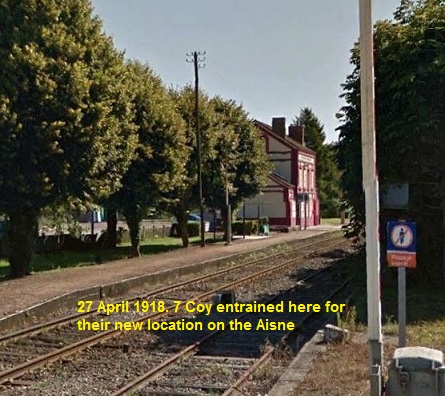
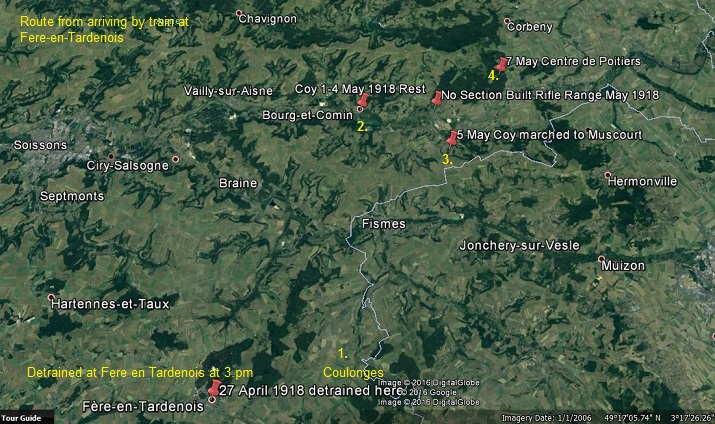
The Third Battle of the Aisne, 27 May - 6 June 1918.
Whilst the first two battles of the Aisne were conducted by Allied forces, predominantly French, against the German army in France, the Third Battle of Aisne, from 27 May-6 June 1918, comprised the final large-scale German attempt to win the war before the arrival of the U.S. Army in France, and followed the Lys Offensive in Flanders.
The focus of the offensive was the Chemin des Dames Ridge, held by the Germans upon their retreat from the Marne in September 1914 until their ejection, at huge cost to the French, during the Nivelle Offensive, also known as the, Second Battle of the Aisne in April 1917.
Erich Ludendorff although subservient to Paul von Hindenburg within the German Third Supreme Command, effectively dictated the planning and execution of the German war effort. He determined to reclaim the Chemin des Dames Ridge from the French with the launch of a massed concentrated surprise attack. In so doing he anticipated that the French would divert forces from Flanders to the Aisne, leaving him to renew his offensive further north, where he believed the war could be won.
At the time of the offensive the front line of the Chemin des Dames was held by four divisions of the British IX Corps, ironically sent from Flanders in early May in order to recuperate. General Duchene, commander of the French Sixth Army, was responsible for the continued defence of the sector, and Lieutenant-General Sir Alexander Hamilton Gordon, commander of IX Corps, was required to place himself under Duchene's direction.
Thus, when Duchene decided to send the British divisions to the front line, Hamilton Gordon, although reluctant to see his fatigued troops further exposed, was obliged to dispatch his men forward. He however recommended to Duchene that a policy of defence in depth be adopted for the eventuality of an attack. Duchene disagreed, preferring to mass troops in front-line trenches.
The attack was launched early on 27 May with a ferocious heavy artillery bombardment of 4,000 guns across a 40 km front, against four divisions of IX Corps. Owing to the heavy concentration of primarily British troops in front-line.trenches, casualties from the bombardment were severe; IX Corps itself was virtually wiped out
The bombardment was accompanied by a gas attack, designed to disable defensive gun crews, after which 17 divisions of German infantry, under Crown Prince Wilhem, began their advance through a 40 km gap in the Allied line.
With the Allied forces entirely taken by surprise, the rapid progress of the German troops was reminiscent of the more fluid war of movement of the opening months of the war.
Between Soissons and Reims the Germans broke through a further eight Allied divisions, four British, four French, reaching the Aisne in under six hours. By the end of the first day the Germans had gained 15 km of territory and had reached the River Vesle. By 30 May the Germans had managed to capture 50,000 Allied soldiers and 800 guns, arriving within 90 km of Paris by 3 June.
Once again a German victory seemed probable. However, as before, problems with supplies and reserves, and troop fatigue, in addition to prolonged Allied counter-attacks, halted the German advance at the Marne. By 6 June the German advance had run out of steam.
French casualties were heavy, with 98,000 losses; their British allies suffered 29,000 casualties. General Duchene was dismissed by Petain, amid an atmosphere of crisis in Paris. Petain's own position was placed under threat, with his role being made subservient to that of the recently promoted Allied Supreme Commander, Ferdinand Foch
The Chemin des Dames 7th to 26th May 1918
During the previous six weeks the 50th Division had carried out two retirements in the face of greatly superior numbers. On each occasion it had fought a series of delaying actions, which had reduced its infantry strength to that of a single brigade or less, the other combatant arms being almost equally reduced. In company with the three British divisions (8th, 21st, 25th), which had undergone a similar experience, it was now dispatched south to what was then considered to be a quiet part of the front-- The Chemin des Dames sector, north of the Aisne - where it formed part of the British IX Corps acting under French Command. The Division was again brought up to full strength. The last but one great German attack took place on this sector and to the east of it on the 27th May when the Division again suffered great losses and experienced a third period of retreat. In this fighting the 7th Company was to lose nearly 70 percent of its strength, in killed, wounded and missing. Detraining at Fere-en-Tardenois on the 27 April the Company marched to Coulognes (6 mile) about 20 miles south-east of Soissons, where a week was spent refitting,etc. On the 5th May it marched to Muscourt (16 mile) and on the 6th to Centre des Poitiers (6 mile), immediately north of the River Aisne between Craonelle and Pontavert, taking over the work and dugouts of the 11/63 French Engineer Company. The new sector included the eastern (Croanne plateau) end of the famous Chemin des Dames position and about 1.½ miles of low-lying front bordering on the plateau. It was much wooded in rear of the front or outpost system and, owing to its length, could only be lightly held. The French Division relieved on this sector spoke of it as ‘’une ligne complete’’, owing to the extensive nature of the trench systems and strong points- all strongly wired on a system of machine gun defence with deep dugouts for all troops in occupation as well as for machine gun detachments, headquarters and reserves together with good subsidiary works. But the readjustments required the wooded nature of the country to be defended, and the entire absence of any efficient gas-proofing of dugouts left plenty of work to be done. The rapid gasproofing of all dugouts was considered to be of first importance. The 7th Company was employed on gas-proofing the whole divisional sector as well as constructing ‘’pillboxes’’for machine-guns. No 2 Section was employed on construction of a rifle range in the neighbourhood of Div.H.Q. At Beaurieux.
Cohan
1-4 May 1918: At rest. The Company did Infantry training. Received lectures from O.C. and Section Officers.
5 May: 6.30 am the Company marched to Muscourt via St Gilles, Fismes and Basweux. The O.C. with advance party of Capt Slattery and N.C.O.s proceeded by motor lorry to Centre De Poitiers between Craonelle & Pontavert and took over work and billets from the 1163 French Engineer Company. This taking over was completed on the 7th May.
Muscourt
6 May: Waiting orders
7 May: 7.30pm The Company marched to new billets at Centre De Poitiers.
Centre De Poitiers
8 May: The O.C. & Section officers & N.C.O.s reconnoitred works taken over from French Engineer Company and works were allotted to respective Sections.
9-26 May: No 1 Section work on wiring and reclaiming trenches and putting into state of defence Ligne de Reduit. A deep dug out was commenced for M.G Emplacement has now completed.
*****************
9-22 May: No 2 Section constructing M.G. Emplacements and construct Pill Boxes for M.G. Crew in Bois de Beau Marias and wiring same. Reclaiming and putting in state of defence, Ligne Intermediare from La Hutte to Bois Des Butte
*****************
22-26 May: No 2 Section working on the construction of a new Rifle Range Beaurieux, working under C.R.E.
******************
9-26 May No 3 Section were working and constructing machine gun emplacements, work on Pill Boxes, wiring trenches at Centre Hoche and Ligne De Soutien, improving sand bags and putting Ligne De Reduit in state of defence, Gas proofing all dug outs of 149 Brigade H.Q at P.C. Calvaire and all dug outs to A,B,C and D Batteries of 250 and 251 Brigades R.F.A.
*****************
9-26 May: No 4 Section work on improvement and construction of new fire bay on Ligne De Soutien. No 4 Section moved into new billets forward, and gas proofing all dug outs in 149 Brigade area under149 Brigade Gas Officer. On 26th No 4 Section moved back to Coy HQ, Centre De Poitiers during the training.
26 May: Orders were received to take all necessary precautions for an enemy gas attack.
27 May: 1 am. A heavy enemy bombardment commenced, which included a large percentage of gas shells. The Sections were warned and took shelter in their gas proof dug outs. It is believed that owing to the absence of orders, Lt Pottle MC was instructed by the O.C. to reconnoitre and ascertain the nature of the situation forward of the Coy billets, but owing to the O.C. Major Baldwin MC and Lt Pottle MC becoming casualties, this cannot be confirmed. It then appears Lt Pottle MC, reported that he enemy were close at hand.
7.45 am; Orders were issued by O.C for the Coy to parade immediately in fighting order, this was in the act of being carried out when the Company was surprised by the enemy, and it appears from evidence that the Sections were overwhelmed and taken prisoners together with all documents and effects of Company office.
Immediately following orders for this I. A. parade, the O.C Major Baldwin DCM was found seriously wounded by shrapnel near Company H.Q. and succumbed to his wound whilst being attended to. Following this, Lt Pottle MC was shot in the arm whilst engaging the enemy at close range with 2nd Lt King. Lt Pottle was evacuated by field ambulance.
9.30 am: 2nd Lt King and a few remaining men retired and joined No 2 Section at Beaurieux at 9.30 am. All communication during the above operation appears to have ceased as no orders for the Coy were received from the time of the communique of the bombardment.
Beaurieux 27 May 1918: No 2 Section on detachment, were clearing roads of all debris during the above bombardment and at about 10 am retired across the river Aisne with the infantry and there met C.R.E. Adjutant and took up battle position left of Maizy remaining there till about 12 pm. Meanwhile sending out patrols on either flank to keep touch. Patrols reported they could not find any troops on either flank. 2nd Lt Rebbeck decided to retire to receive further orders and get in touch with other units, and met C.R.Es adjutant who instructed him to join Coy transport moving to St Gilles. Communication was then established by cycling orderlies with C.R.E. and the Company transport was near at Baslieux and then moved to St Gilles. Here no billeting accomodation could be obtained, and the Coy joined Divisional RE Transport and moved to Cohan Camp.
Cohan
28 May: 4.30 am: Orders were received for the Company to march to Savigny. Company moved off at 6. am via Lagery Lhery and faverolles where all transport was found moving back from the line. Orders were received to move back to Villers Argon and billet for the night.
Villers Argon
29 May: Company moved back to Chatillon sur Marne where verbal orders were received from C.R.E to detail parties to standby in readiness to demolish 2 bridges, one bridge being near Montigny over Le Camp river, and a suspension bridge over River Marne at Pont a Binson. These two bridges was reconnoitred by C.R.E. Capt Smith 447 Field Coy and 2nd Lt Rebbeck & the Coy was ordered to standby and prepare bridge for demolition when ordered. At 4 pm verbal orders by C.R.E were received cancelling this demolition & the Coy was ordered to move to Troissey to collect pontoons from C.E. IX Corps and to assist in constructing pontoon bridge on the River Marne at Troissy. Pontoons from various field Coys were collected and bridging site was shown to 2nd Lt Rebbeck by C.R.E. At 9.30 pm C.R.E. issued verbal orders cancelling this bridging & ordered all pontoons to return to their Companies. The Company bivouacked at Troissy for the night.
30 May: Company marched to Igny under orders to join Company Transport who had proceeded to Igny the previous day. On arrival at Igny the Company received orders to march with the Division to Corribart and moved off from Igny at 2.40 pm & bivouacked at Corribert for the night.
Corribert
31 May: 3 am: Orders were received for the Company's pontoons to proceed under Lt Gude of 447 Field Coy to Damery and moved off at 3 am. At 10 am Company marched to Toulon Le Montagne and thence to billets at Aulnizeux
Photo IWM. Photo title:
Third Battle of the Aisne. British prisoners resting in a flattened trench while being guarded by a German soldier. Near Berry-au-Bac, May 1918.
Above; Trench map copy taken from The 50th Division's war diary, showing Centre de Poitiers.
Above: Centre de Poitiers more prominent on this French copy, kindly supplied with the assistance of the museum, Caverne-du-dragon, located on the Chemin des Dames near to the above site.
http://www.caverne-du-dragon.com/fr/default.aspx
Chris Ellis and George Cowie visited the site of ''Centre de Poitiers'', September 2014. It is preserved by a tranquil rural wooded area.
The site of Centre de Poitiers as it is today.
photo taken 14 September 2014
A short video clip of the above:
https://youtu.be/TG2AajlAp9g
7 Coy list of missing believed Prisoners of War 27 May 1918:-
From the 17th June 1915 until the end of WW1, 7 Field Company RE served with the 50th (Northumbrian Territorial) Division. The Division's three Brigades were 149th,150th and the 151st. At different stages of the war 7 Field Company had supported each of the Brigades. There were three Field Companies RE in the Division:
1st Northumbrian Field Company RE - later changed to 446 Field Company RE
2nd Northumbrian Field Company RE - later changed to 447 Field Company RE.
7th Field Company RE - The only regular unit in the Division
Duck Board recovered from a trench
Right: Map of 7 Company's works area in December 1917 to January 1918.
The works area was mainly between the two roads running parallel in a north easterly direction
Right:
Photo courtesy Brian Weaver.
494991 Spr Clarence Walter Weaver
No 3 Section, 7 Field Company RE
Spr Weaver was taken prisoner on the 27th May 1918 on the front line at Craonnelle when the 50th Division was overrun by the enemy.
He died in captivity in Germany 1.9.1918 of Spanish flu that was pandemic at the time.
Brian Weaver at the site where the Amifontaine POW Holding Camp stood. It is likely his great grandfather, Spr Clarence Weaver, passed through here in May 1918
Amifontaine POW Holding Camp May 1918
Centre de Poitiers, 7 Field Company's location 7-27 May 1918.
Photograph September 2014
Ypres - I.1.d.3.6.
1-2 February 1918: Sections employed as follows No 1 (Lt Pottle) Duckboard track connection from D.11.b.4.3 to D.11.d.8.9. No 2 (Lt Keyworth-Davis) Haalen Switch Posts.
No 3 (Lt Baldwin) Artillery O.P. in Passchendaele (D.6.d.40.87) and maintenance of K and Crest Farm tracks. No 4 (Lt Flattery) Coy HQ at Passchendaele (D.6.d.3.3) and maintenance of H track & K track on rear of Panet Road.
3 February 1918: On February 3rd No 2 Section had one casualty, Spr Goodwin wounded. No 4 Section commenced work on Powder Magazine, Ypres. Adapting same for use as Main Corps Dressing Station. No 1 Section completed connection between Crest Farm and Heine House Tracks.
The Black Horse Trail 2018 visit Centre de Poitiers site
Wreath, poppy and poppy cross left 2018
22 May, No section moved to Beaurieux to construct a rifle range working under the CRE. Survivors at Centre de Poitiers on the 27 May made their way to join No 2 section repairing roads damaged by the German bombardment before retiring over the river Aisne at Maizy.
The Division set up temporary HQ at Concervreux before retiring further on the 27 May.
27 May: British prisoners of war near Berry-au-bac on 149th Brigade's right flank
50th Division sappers taking over the trenches from the French engineers on the Craonne-Pontavert sector
Brian and Brian standing on the site of the strong post, Centre de Marceau. Centre de Poitiers is behind them in the wooded area
The Black Horse Trailers on the platform of Pernes station where 7 Field company boarded a train for Fere en Tardenios, en route to the Chemin Des Dames sector
Estaires
The strong point line 7 Field company constructed 10-11 April 1918
came through this area from Estaires
o
o
o
4a
4b
Right: This small bridge over the river
l' Omignon, east of Tertry was one of three guarded by men of No 2 and 3 sections 22 March pm - 23 March am
4b
O
O
4a
If you have found this section, ''South of the Somme'', interesting, then you must watch this video: 7 Field Company's 'Operation Michael' Trail, 1918, revisited 2018
https://youtu.be/ZxTDmvpONog
7 Field Company RE, South of the Somme 10th March-1st April 1918
23 March, three enemy arcraft flew low over the fields firing at 149th Inf Bde. Troops returned fire including 7 Coy. Two aircraft were shot down. Driver R. White was shot in the leg.
7 Field Company casualties 28 March 1918:
Killed: 159522 Spr J. Clay.
Wounded: 17349 A/Serjt T.F. Wadkinson, 11234 A/Sert P. Cheadle MM. 155680 Spr J. Bowyer,
420352 Spr W. Love, 108876 Spr A. Mitchell, 43809 Lcpl D. Munro, 540516 Spr E. Miller, 89409 Spr W. Smith, 159816 Spr G.Goodwin,
Gassed: 178999 Spr W. Hardy.
Buchanan Wood
The trenches above were the trenches captured and held by 7 Field Company on 27 March. The Company, part of a composite battalion, was later ordered to withdraw, as they were being out-flanked. The Australian Memorial photo above was taken on the 8th August 1918 when the Australians retook them during the last 100 days of the war.
Lt H.G. Pottle MC Injury dated 12 Aug 1918
Right: Colonel H.G. Pottle OBE.MC.MiD. Served in 7 Field Company 1917-18. He was shot and wounded in the arm on the 27 May 1918. (See X-ray right).
He went on to serve in WW2 and helped plan the invasion of Sicily and mainland Italy. As Deputy Director of Transportation, he was responsible for all the ports and railways being used by the British Army in that theatre.
7 Field Company's role in this phase of the war can be seen in this video:
https://youtu.be/Ba5WGLW7q3I
7 Field Company at the Chemin des Dames sector May 1918
https://youtu.be/QLGJOlIu6_g
7 Field Company worked on trenches in this area all the way up to the front line. Also on the otherside of Butte de l' Edmond
Photo, courtesy Robin Farrer.
Right: centre, 22445 Serjt A.M. Farrer pictured as a L/Cpl in 1915. He died of Wounds received at Caulaincourt March 1918


